#sympatric speciation
Explore tagged Tumblr posts
Text
man idk why but i have SUCH a hard time understanding like.... basic genetics. i keep mixing up genes and dna and chromosomes and alleles. please . i have an exam on this on thursday
#and i can understand and remember other stuff for this exam!!#i've got allopatric and sympatric speciation down#i've got pre and postzygotic barriers down#i've got gene flow vs genetic drift down#...... what do genes do? couldn't tell ya#i just need to do more flash cards i think .... save me amoeba sisters.....
8 notes
·
View notes
Text

Eastern North Pacific long-beaked common dolphin Delphinus bairdii bairdii
Observed by chezasaurus, CC BY-NC
A note ...or, brief essay on common dolphin taxonomy
The common dolphin Delphinus delphis sensu lato has a near-cosmopolitan distribution, and considerable variability exists across the globe. Multiple species of common dolphin have been named, but in general there has only been one species recognized. In 1994, a study of common dolphins focused predominantly on the Eastern North Pacific found that the global offshore short-beaked common dolphin Delphinus delphis sensu stricto is different from the long-beaked common dolphin Delphinus capensis found in disjunct coastal areas around the world. The extremely-long-beaked and usually rather-dull-patterned Indo-Pacific common dolphin Delphinus tropicalis occupied a position as either a third species or a distinctive regional form of long-beaked common dolphin.
More detailed genetic studies in the 2010s did not uphold the short-beaked v. long-beaked dichotomy, however. A more complex evolutionary story is revealed by genetics, indicating that the long-beaked morphology developed repeatedly and independently in distinct coastal areas; thus, classification of all the world's long-beaked common dolphins as Delphinus capensis is erroneous as they do not all relate to one another to the exclusion of short-beaked common dolphins. Once again, all common dolphins were a single species.
Not all marine mammalogists were satisfied with solution of recognizing a single polymorphic species with a cosmopolitan distribution, particularly with the regard to the rather well-studied long-beaked common dolphins found on the Pacific coast of the US and Mexico. Despite overlapping geographically with short-beaked common dolphins, these long-beaked dolphins are distinguishable by external appearance, skull characters, mitochondrial DNA, and - to at least some degree - ecology and life history. In addition to the long beak, the broad, dark stripe running from gape to anus along the lower sides of these dolphins and often darkening the side of the face (as seen above) is one of the most recognizable characters. In 2024, a redescription of these dolphins considered them a separate species, the Eastern Pacific long-beaked common dolphin Delphinus bairdii. That paper notes that the Eastern Pacific long-beaked common dolphins off South America, with a >2500km gap from their northern counterparts, may warrant separation as a distinct subspecies. Another genetic study published in 2024 suggests that long-beaked common dolphins in the Western North Pacific may also belong to this species. That is the course followed on this blog - while the exact nature of these dolphins is in need of further study, recognizing such disjunct forms as at least separate subspecies is essentially the standard in other cetacean species.
The days of two globally-distributed common dolphin species are behind us, but what of the other long-beaked common dolphins besides those of the Eastern Pacific? The recent paper revalidating Delphinus bairdii suggests, as others have, that the long-beaked forms remaining at present in Delphinus delphis likely warrant taxonomic distinction. The evidence suggests to me each long-beaked form of common dolphin is probably best regarded as its own independent species, separate from the global short-beaked common dolphin. As tempting as it is to make this the course followed on this blog, I think I shall have to split the difference for now, given that there is evidence that some long-beaked populations are not reciprocally monophyletic with regards to sympatric short-beaks. The lack of complete genetic isolation from short-beaked common dolphins is not necessarily an indicator that specific distinction is unwarranted, but could indicate recent and ongoing speciation, possibly in response to geologically-recent climatic upheavals related to Pleistocene glacial cycles (...plus dolphins are not shy about hybridization). Though I believe further study will probably bear out recognition of additional common dolphin species besides D. delphis sensu stricto and D. bairdii, for now I will be listing other long-beaked common dolphins on this blog as Delphinus "delphis" to indicate their questionable taxonomic assignment.
Recall that the inatungulates blog is NOT a definitive source for taxonomy, and while I base my (generally splittery) taxonomic opinions on information and proposals that are in the literature, I am not beholden to any single source on taxonomy and the opinions here should not be treated as authoritative; hopefully, however, I will prompt an appreciation for (the sometimes-overlooked minutiae of?) ungulate diversity, and send curious readers to investigate the literature to form their own opinions from the available data.
Ref:
Becker, MA, KR Murphy, FI Archer, TA Jefferson, LW Keith-Diagne, CW Potter, MF Urrutia-Osorio, I Ndong, and MR McGowen. 2024. Common dolphin (Delphinus delphis) mitochondrial genomes from Senegal reveal geographic structure across the North Atlantic but provide no support for a global long-beaked clade. Marine Mammal Science e13144.
Cunha, HA, RL de Castro, ER Secchi, EA Crespo, J Lailson-Brito, AF Azevedo, C Lazoski, and AM Solé-Cava. 2015. Molecular and morphological differentiation of common dolphins (Delphinus sp.) in the southwestern Atlantic: Testing the two species hypothesis in sympatry.
Heyning, JE, and WF Perrin. 1994. Evidence for two species of common dolphins (genus Delphinus) from the eastern North Pacific. Contributions in Science 442:1-35.
Jefferson, TA, and K Van Waerebeck. 2002. The taxonomic status of the nominal dolphin species Delphinus tropicalis Van Bree, 1971. Marine Mammal Science 18(4):787-818.
Jefferson, TA, FI Archer, and KM Robertson. 2024. The long-beaked common dolphin of the eastern Pacific Ocean: Taxonomic status and redescription of Delphinus bairdii. Marine Mammal Science e13133.
Segura-García, I, JP Gallo, S Chivers, R Díaz-Gamboa, and AR Hoelzel. 2016. Post-glacial habitat release and incipient speciation in the genus Delphinus. Heredity 117:400-407.
#Delphinus bairdii bairdii#Eastern North Pacific long-beaked common dolphin#Cetacea#Delphinidae#cetacean#dolphin#North America#United States#California#Pacific Ocean#keep reading#posting about taxonomy#that was a long one whoops
30 notes
·
View notes
Text
Spectember Day 4: Sympatric speciation

New Zealand got transformed by the step of humanity, for the few large mammals that remained there like possums and goats, alongside the demise of their unique endemic bird fauna previously and after human colonization, at the end it took millions of years for the same endemic fauna to recover, now with some extra foreign mammal occupants, and for another 20 million years it has come to a proper balance.
This forged the evolution of new ecological interactions, between them a new predator, descendant of the kea that intelligent and skilled was able to survive and cover new niches, turning more predatory. There are other dozens of species of this group that takes in different carnivorous niches, but for this entry only matters two species, they among the largest avian predators. This will be called the Harpy kea (Sarconestor) evolved in a competitive environment alongside birds of prey and large omnivorous possums, upon these they managed to stay at the top in the most forestall regions of the island. Up to 80 cm in height, and a wingspan of 2.5 m the mauling harpy kea (Sarconestor macronychus) is the main oldest species is a voracious bird capable of tear down some of the large now resident goat descendants that resemble a Takin, using their large harpy eagle like feet with large claws. They evolved around 10 to 15 million years after the departure of mankind on earth, now stepping as the apex predators, they would have remained as the only of their own genus if it wasn’t for a subdivision of one population on the same environment and region, this probably caused by a switch on preferred prey.
The second species is the Standing harpy Kea (Sarconestor phonteteres), less robust but more taller species of Harpy kaka, this reaching up to 1.1 meters and a wingspan of almost 3 meters, this one became focused on hunting medium size animals, this includes juveniles of the Takin-like goats, some large terrestrial ratite-like birds that inhabit the dense forests and so varied other animals, this evolved in the last 5 million years, and even though they often overlap in range and prey, both The mauling and stood kea doesn’t compete with each other as they hunt for specific types of prey.
88 notes
·
View notes
Text
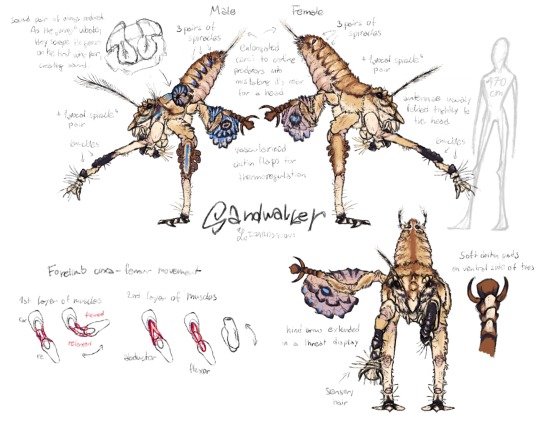
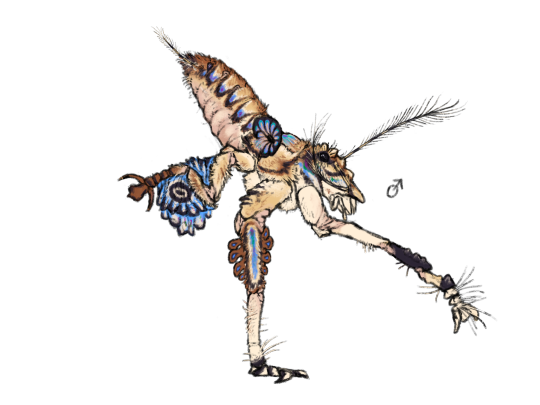
This is a sandwalker, common in the “african” deserts of AfroEuroAustralAsia. These animals belong to a diverse group often called “the Headless”, or “Bluebloods” because most of them look like they lack necks, which isn’t quite true. Their ancestors, the giant malaysian cockroach, ironicaly has a very flexible “neck” for an insect. Some call them “Bluebloods” because they have blue, copper based blood, and also a lot more efficient vascular system than their sixty million years old ancestor. The sandwalkers are rather primitive compared to the other headless, but evolved extremely rapidly like the rest of them.
The malaysian roaches were one of the first animals to re-colonize the islands in oceania devastated by human activity (it was also very common for them to raft since the ocean levels were quickly rising) and so they appeared in an environment with many unoccupied niches and no predators with the exception of birds, that later established populations on said islands too. A lot of the already big roaches grew even bigger because the bigger you are, the more you can eat and the harder it is for the birds to swallow you. Larger individuals would also have slightly different calls due to their body shape, and so they would more likely socialize and mate with similarly sized roaches, resulting in a very slow sympatric speciation contributing to the headless’ / bluebloods’ evolution. The manmade nanite activity has driven many species to extinction, but in case of these giant roaches, they speeded up their enlargement process, because the odds we on their side and the nanites caused several random mutations that contributed to the developement of active respiration and later complex vascular system. As the sea levels were decreasing, the islands of what was previously Malaysia, Indonesia, Papua new Guinea and the neighbouring countries, increased in numbers, size and diversity, and so did the headless. They later dispersed into what used to be Australia, where they also thrived. When Australia started colliding with Asia (ca. 50my after human extinction), the headless experienced a huge decline because of the competition from mainland animals, but a few of them have managed to spread far into the west into Africa, which by now was separated from Asia and Europe by tall mountains instead of the sea. And among these bluebloods are the sandwalkers.
Oh and about the organ on the male’s back? These are modified wings. Giant malaysian cockroach females lack wings completely, and so do the sandwalker females. Males use these “wings” to serenade for the females with chirps and buzzes. The hind wing became a stump, while the fore wing went harder and immobile, completely encircled the hind wing and fused with the carapace. Males create these sounds by stridulation, vibrating the hind wing while it is in contact with the grooved carapace. The immobile fore wing acts as a sound amplifier. Different headless species have different shapes of these structures, creating vastly different mating calls. The larger ones make sounds similar to a pitched-down chainsaw and can travel for houndreds of meters.
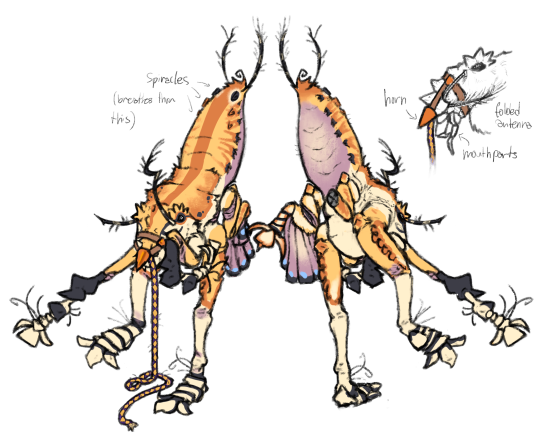
And here’s a bit more cartoonish one. Her name is Head and she belongs to a young Yuo Yowa (a species not introduced yet) merchant who travels around the desert and sells low quality salt for high prices.
#artists on tumblr#creature design#digital art#speculative evolution#worldbuilding#spec bio#spec evo#speculative fiction#oc art#small artist#art
108 notes
·
View notes
Text
Plant Parasites Fool Scientists with Stealth Evolution
Plant Parasites Fool Scientists with Stealth Evolution https://ift.tt/E9uovCB Is it nature or nurture that has the biggest effect on your development? Clara de Vega and colleagues looked at a parasitic plant, and found there was a lot more to Cytinus hypocistis than its genes. C. hypocistis is a plant that that grows inside the roots of plants in the Cistaceae family. de Vega and colleagues examined three different “races” of C. hypocistis, each specialised to a different host species within the Cistaceae family. They found that while the plants looked similar, each had developed in its own unique way. Cytinus parasites growing on different host plants flowered at different times, with up to a month between the earliest and latest groups. When the plants did flower, parasites on some hosts produced more flowers with higher nectar sugar concentrations. Hand-pollination showed the plants were interfertile, yet the differences in when and how they flowered may be acting as a barrier to this happening naturally. de Vega studied six populations of Cytinus growing on three different host plant species in southern Spain. It was here they recorded flowering times, measured flower sizes and nectar production, and conducted cross-pollination experiments. The researchers then used statistical tests to analyze differences between the parasite groups. Most previous research on parasitic plants has focused on them as crop pests, not wild species like Cytinus. This closer look reveals hidden diversity in parasitic plants that appear similar but are genetically and functionally distinct. de Vega and colleagues argue this raises the question of whether we are looking at one species, or a case of cryptic speciation in progress. de Vega, C., Ortiz, P.L., & Arista, M. 2024. Host-driven phenotypic and phenological differentiation in sympatric races of a parasitic plant. Flora. https://doi.org/10.1016/j.flora.2024.152617 (OA) Cross-posted to Bluesky, Mastodon & Threads. Cover image: Cytinus hypocistis by Luis Nunes Alberto – Own work, CC BY-SA 3.0, Link The post Plant Parasites Fool Scientists with Stealth Evolution appeared first on Botany One. via Botany One https://botany.one/ October 03, 2024 at 12:30PM
3 notes
·
View notes
Text

Specposium's Spectember day 4: Sympatric speciation
"Sympatric speciation is the evolution of a new species from a surviving ancestral species while both continue to inhabit the same geographic region. In evolutionary biology and biogeography, sympatric and sympatry are terms referring to organisms whose ranges overlap so that they occur together at least in some places. If these organisms are closely related (e.g. sister species), such a distribution may be the result of sympatric speciation."
When i read this i realized that this was exactly what is happening in Batrachiterra right now, so i drew this sketch of the Cane toad(left) and its descendants, the Water cane toad(middle) and the Carmesim toad(right). Will turn this into a full piece later(hopefully).
To know more about these check:
#specposium#spectember#spectember 2023#worldbuilding#art#illustration#spec bio#speculative biology#spec evo#speculative evolution#speculative zoology#batrachiterra#toad#cane toad
10 notes
·
View notes
Text
Spectember Day Four: Sympatric Speciation
The “Garbage Crows” is a colloquial term for a group of crow descendants that originated in the year 3061 that are found across Eurasian mega cities. They are called garbage crows for being found around dumps and trash piles with different behaviors to obtaining food
Carnocorax Carnifex (butchering Meat Crow):
These crows are considered “rippers”, they use their muscular neck and their sharp and robust jaw to cut into bags, boxes, etc. they are also capable of hunting rats and other small creatures.
Carnocorax Gluosus (gluttonous Meat Crow):
Being “Gulpers” they often eat a wide variety of foods in trash piles. They have adapted to consume anything rotten with the ability to separate plastics and styrofoam by regurgitating it.
Carnocorax Grosa (Scrapping Meat Crow):
The rarest of the Garbage Crows, these “scrapers” are often show up after the other crows have had their fill. They use their preening beaks to pry into tight areas and scrape off any edible matters

#speculative biology#speculative ecology#speculative evolution#traditional art#speculative zoology#traditional sketch#crows#crow art#specposium#day 4
2 notes
·
View notes
Text
Re: the butterfly/caterpillar quotation I reblogged earlier, some remarks in the replies suggested there was science supporting the idea that information persists between these two states, so I went & looked for it. The answer seems to be 'It can persist as long as it's acquired at a neurologically appropriate stage of larval development.' Here are some links, in case you're curious like I was:
'Butterflies Remember Caterpillar Experiences' -- New Scientist scicomm synopsis
Retention of Memory through Metamorphosis: Can a Moth Remember What It Learned As a Caterpillar? -- Blackston et al., 2008 PLOS One paper, open access
Abstract of the above, my emphasis: Insects that undergo complete metamorphosis experience enormous changes in both morphology and lifestyle. The current study examines whether larval experience can persist through pupation into adulthood in Lepidoptera, and assesses two possible mechanisms that could underlie such behavior: exposure of emerging adults to chemicals from the larval environment, or associative learning transferred to adulthood via maintenance of intact synaptic connections. Fifth instar Manduca sexta caterpillars received an electrical shock associatively paired with a specific odor in order to create a conditioned odor aversion, and were assayed for learning in a Y choice apparatus as larvae and again as adult moths. We show that larvae learned to avoid the training odor, and that this aversion was still present in the adults. The adult aversion did not result from carryover of chemicals from the larval environment, as neither applying odorants to naïve pupae nor washing the pupae of trained caterpillars resulted in a change in behavior. In addition, we report that larvae trained at third instar still showed odor aversion after two molts, as fifth instars, but did not avoid the odor as adults, consistent with the idea that post-metamorphic recall involves regions of the brain that are not produced until later in larval development. The present study, the first to demonstrate conclusively that associative memory survives metamorphosis in Lepidoptera, provokes intriguing new questions about the organization and persistence of the central nervous system during metamorphosis. Our results have both ecological and evolutionary implications, as retention of memory through metamorphosis could influence host choice by polyphagous insects, shape habitat selection, and lead to eventual sympatric speciation.
3 notes
·
View notes
Text
Among the most popular pet frogs, and among the most charming, are the fire-bellied frogs or toads - in the strictest sense, they aren't either - such as Bombina variegata, the yellow-bellied toad of the Western Palaearctic realm, and specifically Central and Southern Europe. This is a small and easily housed frog species, growing to a snout-to-vent length of 2.8 to 5.6 centimeters, or about 1 to 2 inches.
Within this species, racial differences exist in their markings across their geographical range. The northeastern populations are genetically distinct from their conspecifics in the rest of its distribution, to their west and their south. This deep divergence implies a pre-glacial common descent, and long isolation owed to climatic factors. For this species, the Carpathian Mountains were an ecological refuge, from uninhabitable Pleistocene climates. Also an Italian race of yellow-bellied toads, is often nowadays elevated to full species tank, as B. pachypus.
Bombina is a member of the costate frogs, a clade that also includes the well known genera Discoglossus and Alytes, the painted frogs and midwife toads. Costate frogs competently walk and hop, but they are not long-range jumpers. The costates are not only early diverging, but also protomorphic, retaining unspecialised pelvises that reflect their locomotor conservatism. It is the rearrangement of the pelvis in certain, unrelated frog clades, that allows such derived frogs to jump perfectly.
Bombina sp. are collectively known as the fire-bellied toads, because of their easily visible, yellow to red underbellies. As in those newts with a similar ventral coloration, this has evolved as an aposematic warning, or an advertisement of their toxicity to deter potential predators. To make obvious their coloration, these amphibians display their bellies when they are threatened by a larger carnivore, by flipping onto their own backs, or by employing the body language of raising up - this is the famous 'unken reflex'.
The species of Bombina are distributed from Europe across to Siberia and down beyond China. They are truly a Palaearctic faunal component, but their distribution is non-continuous, which is a result of ancient climate changes. There is an early divergence within the genus Bombina, separating a southern subclade, known as the B. maxima complex, and also a secondary division within the more northerly group, into the European group and the eastern B. orientalis.
At lower elevations, B. variegata lives in deciduous forests, whereas in higher terrain it is a denizen of conifer forests. A habitat generalist, B. variegata utilities diverse lentic and lotic waters. Relative to a sometimes sympatric Bombina species, B. bombina, it eats more terrestrial arthropods than aquatic prey in the wild. This fact allows for some niche partitioning where both species of Bombina are present in the wild.
Although the two species of fire bellied frog are quite distinctive in their looks and vocaluzations, they hybridize readily. However both morphospecies remain distinct, owing to natural selection disfavoring the fertile hybrids that result from these pairings. Thus in the case of these two Bombina species, racial mixing does not result in de-speciation through hybritity, nor has it resulted in the evolution of a new species from the hybrid stock.
B. variegata inhabits temperate, seasonal climates and the daily temperature it experiences, can shift by up to 10 degrees in the course of a day. A study of a B. variegata locality, found that the water temperature was 4 to 24 degrees centigrade, depending on the season. Whilst the air temperature there was 3-31 degrees. (At other localities where B. variegata is present, the water temperature may itself be 31 degrees.) Their season of activity begins at 8-10 degrees centigrade
B. variegata and other Bombina species need to have only shallow water provided for them, because they do not make deep dives for their food. Ideally, these anurans should be able to stand on their toes, reaching up so their faces are above the water. These anurans receive UV wavelengths as daylight in the wild, and benefit from a UVB emitting light source in the aquaterrarium. Bombina sp. do not damage live plants, and are thus suited to a planted aquaterrarium.
Some people have successfully cohabited Bombina sp. with other animals species, but there are risks. These frogs can reflexively lunge at animals that are perceived prey, and their glandular skins are themselves toxic, possibly creating problems should other animals come into contact with their skins. Nonetheless, similarly sized climbing animals, like tree frogs and anoles have been cohabited with Bombina sp. because they inhabit different areas of the enclosure, which minimizes interactions. Regarding conspecifics, male Bombina sp. may be aggressive to one another. The males of these frogs, have longer forearms than to the females.
However, on the down side, Bombina sp can (sometimes) be difficult to feed on a proper captive diet. Often, Bombina adapt to taking items such as floating sticks. Therefore it is untrue that their intended food needs to move, without which the feeding response cannot be stimulated. However, this does not mean that all individuals in these species, are equally willing to do so.
Non-living items in the water are more likely to elicit a feeding response, because chemosensory cues travel better through water than through air, however, contrary to popular factoids, it has also been argued for decades that frogs can see non-moving items, and recognize them as food. I am aware that frogs belonging to distantly related taxa, can and do eat pre-killed prey - these are costates, pipids, bufonids, hyloids, and ranoids.
It is widely reported, and I can see no reason to doubt it, that the species of Bombina differ in their temperature tolerances and optimums. All species of Bombina should be fine at cool room temperatures year round, in a cool temperate climate. That is to say, when and where it is suitable for humans to live comfortably, without feeling hot.
Despite being quite southern in its origin, the popular giant fire belly species, B. maxima from high altitudes in southern China, is said to require lower ambient temperatures, than do the European species. But I know for a fact that B. maxima can be acclimatized, like members of the more northern clade, to an ambient temperature of 24 or 25 degrees centigrade. And I am positive that these frogs encounter such temperatures, which are scarcely soaring, in their wild, subtropical latitude habitats.
Although the B. maxima species complex, which extends to Taiwan and northern Southeast Asia, include the largest of the fire bellied frogs, but even they are not huge. It is rare for individuals to exceed 6 and a 1/2 centimeters, or 2 and a 1/2 inches long. There is still systematic disagreement between herpetologists, as to which populations within this clade constitute separate species, or for that matter, the extent of the different species recognised within this phylogenetic nexus.
The archetypal fire-bellied frog, the European B. bombina, is less commonly encountered in exotic retail, than is the Oriental or Korean fire-belly, B. orientalis. This is a very similar animal to the western B. bombina, the European fire-belly, but the East Asian species has a distribution from the Amur region down to northern China. This is a popular species for those interested in studying animal behavior. It grows to 4 or 5 centimeters, or 1 and a 1/2 to 2 inches.
#Bombina variegata#yellow-bellied toad#fire-bellied toads#fire-bellied frogs#aquaterrarium pets#Bombina maxima#Bombina orientalis
0 notes
Text
BIO STUDYING CRAMING LOL
A gene pool refers to the combination of all the genes (including alleles) present in a reproducing population or species.
GEOGRAPHICAL CONTEXT: where populations are as speciation proceeds applies to all organisms
Sympatric speciation: Speciation without geographic isolation
Allopatric (different places) speciation = Speciation after geographic evolution (Live in different places and there's no gene flow between them)
Isolation populations adapt to local conditions in different regions
Reproductive isolation can evolve as accidental by product
They can't/won't interbreed if they meet again

Where does biodiversity come from?
Diversity within species -> microevolution
Where does it go?
Extinction (loss of species)
Family contains 1 to many genera
Genus contains 1 to many species
Speciation + extinction: Biodiversity increases and decreases
Mass extinction: Rapid loss of large % of biodiversity
There have been 5 so far
Biodiversity takes over 10s of million years to recover
Biggest example: Permian-Triassic extinction
750% of families lost
Best supported reason why: run away climate change
Anthropocene Extinction
New geological age, beginning @ industrial evolution
Ex: Insects (group with great biodiversity)
Extinction will have reverberating effect on biodiversity of other groups

Ways complex traits can evolve:
1) Simple transformation series: (what it does) stays the same
1A) Series of (gradual) stages from ancestral to present day forms
Trait function stays the same
Ex: Horse feet: evolution towards use of middle toe for walking
1B) Plausibility argument
Do prospectively intermediate stages exist in different species
Ex: Eye evolution in molluscs (squids in this case)
Flat retina: Cells with opsin on skin
Cup shared retina: Detects light direction
Pinhole pupil, lens, iris: improves acuity (at diff light levels)
2. Functional shift: Function changes as trait evolves
2A) A trait with 2 functions specialize to do only one of those functions
2B) 2 traits sharing the same function specialize to do diff functions, or one is lost
3. Simplify a more complex trait
Ex: Insects have 2 pairs of wings
All flies have 1 pair of wings, reduced hindwings (also a functional shift)
Irreducibly complex? Eliminate all three!

ORIGIN OF LIFE
SOMETHING TO UNLEARN: ORGINATED IN 'PRIMORDIAL SOUP' OF CHEMICAL BUIDLING BLOCKS AND LIGHTNING STRIKES. THIS DID NOT HAPPEN
Geological context:
1) Age of Earth: ~ 4.6 billion years old
2) Oldest bit of crust: Zircon crystals 4.37 billion years old
3) Oldest rocks: ~4.2 million tears old
(Biological) Life originated:
4) First candidate for biochemical signs of life: 3.8 billion years ago
5) Oldest fossil so far: 3.465 billion years old (looks like fused cells)
Sun gradually becomes dominant energy source for life
02 is a waste product
Cyanobacteria: 2.7 billion years ago. May have had primitive photosynthesis.
Atmosphere reaches O2 concentration 2.4 billion years ago
6) O2 rich atmosphere: ~2.4 billion years ago
Earliest modern photosynthesis ~2.7 billion years ago
Present day earth: Highly environmental O2 concentration
Pre-biotic Earth: Earliest rocks with fossils, lowest O2 environmental concentration
Energy sources before sunlight:
Key feature of life: Highly organized chemical reactions
Requires chemistry-based energy sources
Creating/breaking chemical bonds to release energy
Ex: Photosynthesis uses light to create chemical bonds
Energy-rich chemical environments deep sea vents:
Warm (not hot) temperatures -> faster reactions
Sources of "building blocks" for nucleotides, lipids, amino acids
Many inorganic catalyst to build them and facilitate other pre-biotic reactions
EX: Lost City, hydrothermal vent (low seepage rates)

ORIGIN OF LIFE
"Tree of Life": Phylogeny of all organisms
Last Universal Common Ancestor
Must of had:
DNA
RNA
With genetic code
Proteins
With 20 amino acids
Plasma (cell)
Membrane
Cell cycle (mitosis, cell division, etc)
Biochemistry of complex metabolism: glycolysis, Krebs cycle, etc
Evolution is a chicken and egg problem, DNA, RNA, proteins, membranes, and metabolism had to all arise and work together at the same time.
RNA WORLD HYPOTHESIS

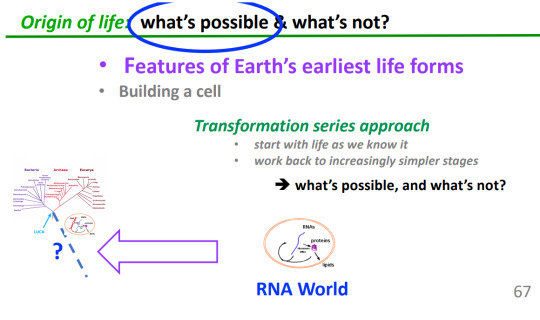

Natural selection began as soon as RNA began to self-catalyze
RNA molecules are different
Some RNA molecules copy themselves better than others because of their nucleotide sequences
Nucleotide sequence differences are inherited
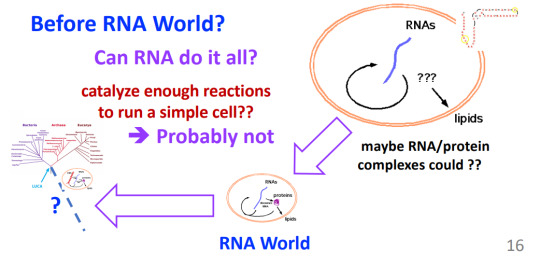

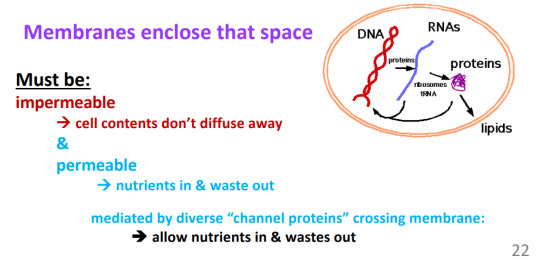

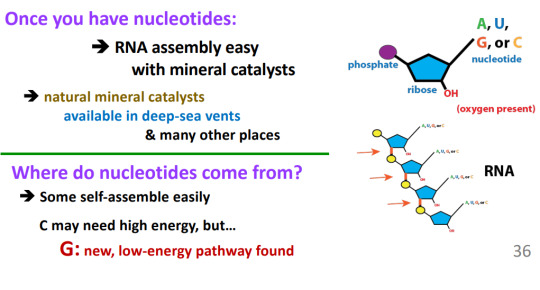

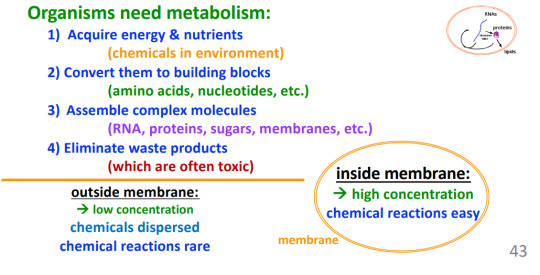

I GIVE UPPPPPPPPPPPPPPP

Evolutionary tree of the homins
Bipedalism -> walked up right
1) Sahelanthropus: 6.5 - 7 mya
Evidence: Femur structure, hip joint, foreman located under head's center of gravity
2) Ardipithecus: 5 mya
Opposite toes=climbing and walking
Monkey like
Key insights to what great ape ancestors might look like
FACT: Complex trait can revert functionally, but rarely to original morphology
Did humans evolve from chimpanzees? No.
Austrapolic afarenis
"Lucy"
Fat, human like foot
Australopithecus garnhi
2.6 mya
Earliest manufactured stone tools
Homo-habilus
Large brain size evolving
Large brain possible when high meat diet
As many as 9 species of human coexisted at the modern humans evolved (7 shown here, 2 more known from DNA)
Homonaledi
South Africa
350,000 - 200,000 years ago
Deep in South African caves
May have used fire (buried and sacrificed their dead)
and 2 hobbits
Died out around when modern humans arrived
On islands till humans got to them
They...
Independently evolved from Australopithecus
Small brains
Flat feet, so no arch
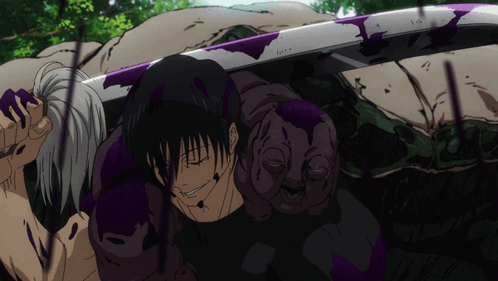
DNA-based phylogeny
Last 800,000 years
DNA extracted from bones
Neanderthals: Eastern and Western
Lived from 400,000 to 35,000 years ago
Lived in Europe and North-Central Asia
Had pale skin and red hair
Denisovan: North-Central Asia
Lived from 400,000 to 70,00 years ago
DNA reveals: alleles for darker skin
Known for a few teeth and small bones
Ancient human species interbreed.
At least 6 cases of interbreeding in early humans
One girl from Denisova cave had a Deni father and Neanderthal mother
Look at bone structure and chromosome
Modern human chromosomes carry small pieces of other species DNA
Sub-Saharan African: from mystery hominin #2
East Asian and Europeans: From Neanderthals and Denisovans
INTROGRESSION INTO MODERN HUMANS -> NOBODY IS PURE HUMAN!
East and Central Asians, and Europeans: From Neanderthals
1.5 - 3% of Neanderthals DNA in Europeans
Many deleterious: risk increase for heart disease, skin cancer, and depression
Benefits: pathogen resistance, and more expected
What can mitochondria and Y chromosomes tell us?
Mitochondria:
Have their own DNA = mDNA
Inherited from mother via egg
Y chromosomes:
Inherited via father only
MODERN HUMAN MDNA
High diversity of human mDNA variants:
Color: Major groups of genotype, each with their own minor variants
Where did first ancestors of all modern humans live?
Africa
"Mitochondrial Eve"
Woman who carried common ancestor of all humans' mtDNA
2 daughters -> one mutation
208,000 and 60,000 years ago (2014 estimate)
Y-Chromosome Adam
Man who carried common ancestor of all men's y chromosomes
-230,00 and 60,000 years ago
Difference not statistically different (2015 estimate)
Difference not statistically different

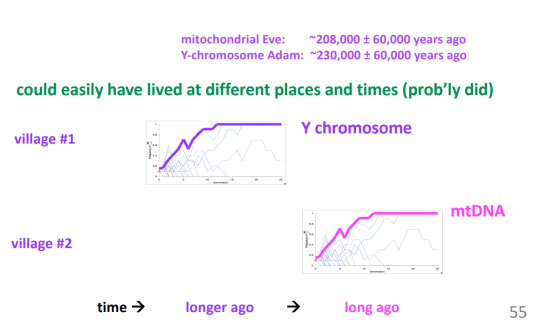
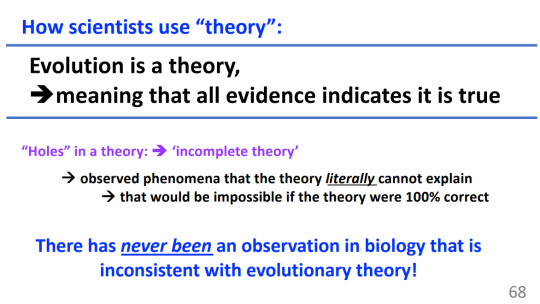
0 notes
Text
[draws something mildly suggestive during a lecture on speciation] [brain filters it into "she sympatric on my speciation till my allele frequencies change"]
1 note
·
View note
Text
Fwd: Graduate position: CharlesU.PlantPolyploidy
Begin forwarded message: > From: [email protected] > Subject: Graduate position: CharlesU.PlantPolyploidy > Date: 13 February 2023 at 06:29:20 GMT > To: [email protected] > > > PhD position: Evolution of reproductive isolation in a diploid – > polyploid plant system > > Research group: The Čertner Lab - Plant Adaptation and Speciation > Department of Botany, Charles University, Prague, Czech Republic > https://ift.tt/0mNzUdC > > Deadline March 13, 2023 > > Polyploidization (whole genome duplication) is widely regarded as an > important mechanism of sympatric speciation, particularly in plants > where it drives reproductive isolation of many crop species from their > wild relatives. While often perceived as a strong and instantaneously > forming reproductive barrier, empirical data show its strength may > vary considerably across plants. In the project, the successful > applicant will be assessing rates and evolutionary significance of > inter-ploidy introgression across a diploid - tetraploid hybrid zone, > looking for genomic signatures of selection and complementing it with > multigenerational manipulated crosses that will allow studying separately > the contribution of different components to overall reproductive > isolation. By using an interdisciplinary approach combining field > research, ex situ experiments, and population genomics on a carefully > selected non-model species from the Asteraceae family, we will aim at > providing new insights into the reproductive isolation of polyploids. The > project builds on a detailed knowledge of the plant system and preliminary > data gathered during previous research. The student will become a > member of a gradually forming team led by an early-career group leader, > will have opportunities to actively interact with other research groups > focusing on polyploidy in plants (within the same building), network with > collaborating teams abroad, and benefit from a friendly atmosphere at the > Department of Botany. We offer creative and supporting atmosphere in the > team, interdisciplinary training in plant research, competitive salary > on top of a PhD scholarship, health and social security insurance fully > covered, support for arriving foreign employees (Staff Welcome Centre of > the university), becoming part of a diverse community of international > STARS PhD students, and work in the vibrant historic centre of Prague. > > Please submit your CV, contact details for two referees and a half-page > motivation letter via the STARS PhD programme https://stars-natur.cz/. > Review of the applications will begin on March 13, 2023 and will continue > until the position has been filled. The exact start date is negotiable. > > Martin Certner > Department of Botany > Faculty of Science, Charles University > Benatska 2, 128 00, Prague, Czech Republic > [email protected] > > "RNDr. Martin Čertner, Ph.D."
0 notes
Text
I have grapheme-colour synaesthesia, including numbers, and I suck at maths lol.
The problem for me is that sometimes I will remember the colour of a word/letter, but different words & letters can be very similar colours. One time I couldn't remember the term "sympatric speciation" in a biology test, but I could remember that it was yellow. Except I ended up incorrectly writing "parapatric", because s and p are both yellow, but p is a very slightly lighter shade. Overall my synaesthesia has very little effect on my life either way lmao
Parts of my synesthesia have faded quite a bit with age but anyways I’ve learned recently that apparently not everyone feels sounds touching them
387 notes
·
View notes
Text
On Soil and Speciation
Many of you will undoubtedly be familiar with some variation of this evolutionary story: A population of one species becomes geographically isolated from another population of the same species. Over time, these two separate populations gradually evolve in response to environmental pressures in their respective habitats. After enough time has elapsed, gradual genetic changes result in reproductive isolation and eventually the formation of two new species. This is called allopatric speciation and countless examples of this exist in the real world.
At the opposite end of this speciation spectrum is sympatric speciation. Under this scenario, physical isolation does not occur. Instead, through some other form of isolation, perhaps reproductive or phenological, a species gives rise to two new species despite still having contact. Examples of this in nature are far less common but various investigations have shown it is indeed possible. Despite its rarity, examples of sympatric speciation have nonetheless been found and one incredible example has occurred on a small oceanic island off the coast of Australia called Lord Howe Island.
Lord Howe Island is relatively small, volcanic island that formed approximately 6.4–6.9 million years ago. It is home to four distinct species of palm trees from three different genera, all of which are endemic. Of these four different palms, two species, Howea belmoreana and Howea forsteriana, are quite common. Interestingly enough, H. forsteriana, commonly known as the kentia palm, is one of the most commonly grown houseplants in the entire world. However, their horticultural value is not the most interesting thing about these palms. What is most remarkable is how these two species arose.
Multiple genetic analyses have reveled that both species originated on Lord Howe Island. This is kind of odd considering how small the island actually is. Both palms can regularly be found growing in the vicinity of one another so the big question here is what exactly drove the evolution of their common ancestor? How does a single species growing on a small, isolated island become two? The answer is quite surprising.
When researchers took a closer look at the natural histories of these two species, they found that they were in a sense isolated from one another. The isolation is due to major phenological or timing differences in their reproductive efforts. H. forsteriana flowers roughly six weeks before H. belmoreana. Flowering time is certainly enough to drive a wedge between populations but the question that still needed answering was how do such phenological asynchronies occur, especially on an island with a land area less than 12 square kilometers?
As it turns out, the answer all comes down to soil. Individuals of H. belmoreana are restricted to growing in neutral to acidic soils whereas H. forsteriana seems to prefer to grow in soils rich in calcarenite. These soils have a more basic pH and dominate the low lying areas of the island. Growing in calcarenite soils is stressful as they are poor in nutrients. This physiological stress has caused a shift in the way in which the flowers of H. forsteriana mature. When found growing on richer volcanic soils, the researchers noted that the flowers mature in a way that is more synchronous, not unlike the flowers of H. belmoreana.
Thanks to their attention to detailed life history events and conditions, researchers were able to show that soil preferences caused a phenological shift in the flowering of these two related species. Because they flower at completely different times when growing on their respective soil types, enough reproductive isolation was introduced to disrupt the random mating process of these wind pollinated palms. As soon as such reproductive biases are introduced, speciation can and will occur.
Photo Credits: [1] [2] [3]
Further Reading: [1]
#lord howe island#phenology#speciation#Howea belmoreana#palm tree#Howea forsteriana#soils#kentia palm#evolution#sympatric speciation
73 notes
·
View notes
Note
How did Saffron meet the gf?
OHH ANON. ILY. OC TIME. it's very unlikely i'll ever actually write the whole stories out but ocs are a fun thing to think about
First of all, who is Saffron? Saffron is a lizard. She is a shapeshifter technically so she could be whatever but sometime in life she decided she wanted to be a lizard, so she is.
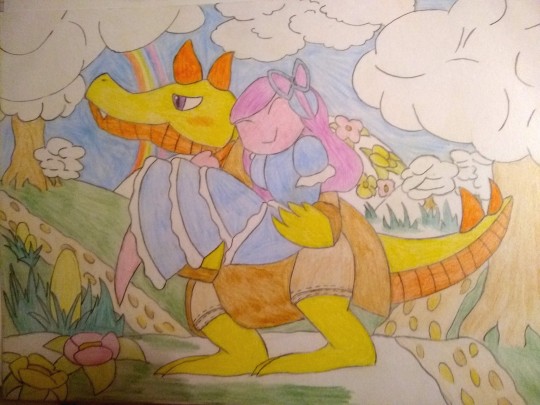
here's a super old 2018-ish picture of her and the gf, Riley. Riley is actually the One Oc To Start Them All, meaning i made Riley first because of a Kirby Theme Week back when I used Amino (don't use amino it's bad).
These two mfers are the protags of one of the main stories of my Oc Cinematic Universe, Starlight Wishes (the other being Devil's Double staring Jay and Eni, because I like coming up with snappy names)
So. Backstory. One day, Jay, Saffron's brother, was walking through the woods (as you do) stepped on a live unexploded landmine (as you do when you are European, except this is Modern with Magic Europe, so it's not Europe).
this is because Jay started as an isekai self insert, which he still kinda is, and i decided life unexploded landmine was the funniest way to die
After the whole explosion thing, Jay met god. God is One of Two Gods, and she is a spider. I've currently forgotten her name but i have it written in a world file somewhere. Her name starts with T.
God is divorced, and her ex, Rinthera, is the death to her life. He's the god of death. Their divorce was messy. She found out some idiots are trying to resurrect her ex (read as: wake him from his post tantrum nap), and she really doesnt want to deal with this. Thus, she makes a deal with Jay: get back to life, and in return, prevent the ritual that'll call Rinthera to the physical plane of existence.
Except, when she drops Jay back down to earth, she makes a critical mistake: not accounting for the fact he was blown sky high and she snatched him right out the air. He falls. He hits his head. You can imagine what happens because this is fantasy tropes land: he loses his memory, and thus also his memory of the deal he made with god.
(this is the inciting incident for devil's double, which i will cease talking about)
result of losing your memory: you go MIA. Saffron gets annoyed. Then, she gets worried. Then, she sets out to search for him.
She's not very successful. She travels with a big sword because I think big swords are cool. So she ends up becoming like, a lizard swordswoman bounty hunter type shit. She WILL do your sidequests for you, that kind of deal.
One day, while she is out doing stuff, she hears tale of a dragon ravaging the fields of some farmer. She gets there, only to find out that the dragon is,,,,, a big doll. A really big life sized stuffed dragon doll that can also spit fire.
Said dragon is terrorizing a certified Maiden In Distress: long flowing hair, pretty petite dress, that type of deal. Saffron, being Saffron, defeats the doll dragon with her superior reptilian might, and approaches the girl. The girl, as it turns out, did not need rescuing, because she is a ghost, and thus, already dead.
As you might guess, this ghost is Riley, the deuteragonist / love interest of Starlight Wishes, the story I came up with when I was fixating on Kirby.
Riley says that there's basically just a whole outbreak of doll monsters, and she wants Saffron's help to stop them, since Riley has no physical form of her own. However, Riley can provide backup by possessing the dolls Saffron defeats!
Thus, we get to the entire plot of that particular story, in which the various ups and downs of hunting dolls together.
The two of 'em are pretty friendly with each other initially, buuuuut. Riley's not entirely honest. Such as the reason why she's a ghost to begin with, and what her unfinished business entails besides the whole doll deal.
I dunno if I wanna say it because it's like, the big plottwist of the whole thing, but I'm also prolly never gonna write it all so. Riley was killed by a knight because she was an "evil" wizard who just kept creating a fuckton of dolls that ended up going out of her control bcuz she was lonely :( why'd you kill her camilla. wait i know why, because you don't give a shit. c'mon camilla.
I genuienly can't get into the clusterfuck of a love confession for these two without explaining literally everything because it takes places at the story climax and it is very dramatic, involves a dragon besides the doll one, death lazers, screaming, the mortifying ideal of being loved, and kirby bossfight aesthetics, because i used to think of it more like a kirby fangame than a story, ykno.
After that whole world destruction deal is resolved and both of them get mental stability they realize they do love each other a lot and get together after Riley pulls shenanigans on a minor deity to get her body back. Hooray for necromancy! Shouldn't have abandoned your pet dragon if you didn't want that to happen, should you, god?!
Does Saffron actually end up finding Jay at some point? Yeah, when she goes home after a long day of doing sidequests with her gf and she turns on the TV to breaking news.
Love wins <3
#Feli gets asked#Feli's ocs#oc lore oc lore oc lore.#i NEED to redesign starlight wishes chars they're just all kirby looking mfers. nika was inspired by the snowman guys#long post#Riley 🤝 Jay: spawning entire stories around themselves#call that uhhh sympatric speciation#<- advanced bio course haver
6 notes
·
View notes
Photo





@orange-nerd gave me this idea, and i don't know whether to thank them or to punch them.
#anyway here's sympatric speciation explained in terms of mormons and newsies#you're welcome#hannah rambles#newsies#book of mormon#the book of mormon#bom#biology#studyblr#kinda i guess 😂😂#brotp: slutty slutty fireworks#friendos
338 notes
·
View notes